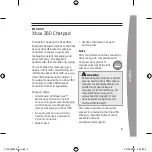
BASIC OPERATION AND FEATURES
SX TRANSISTOR CONTROL
Page
4
Section 1. 2 Solid-State Reversing
The direction of armature rotation on a shunt motor is
determined by the direction in which current flows through
the field windings. Because of the shunt motor field,
typically only requires about 10% of the armature current at
full torque, it is normally cost effective to replace the
double-pole, double-throw reversing contactor with a low
power transistor H-Bridge circuit (Figure 4).
By energizing the transistors in pairs, current can be made
o flow in either direction in the field. The field and
t
armature control circuits typically operate at 12KHZ to
15KHZ, a frequency range normally above human
hearing. This high frequency, coupled with the elimination
of directional contactors, provides for very quiet vehicle
operation.
he line contactor is normally the only contactor required
T
for the shunt motor traction circuit. This contactor is used
or both pre
f
-charge of the line capacitors and for
emergency shut down of the motor circuit, in case of
problems that would cause a full motor torque condition.
The line can be energized and de-energized by the various
ogic combinations of the vehicle, i.e. activate on key, seat
l
or start switch closure, and de-energize on time out of idle
ehicle. Again, these options add to the quiet operation of
v
he vehicle.
t
ection 1. 3 Flexible System Application
S
Because the shunt motor controller has the ability to
control both the armature and field circuits independently,
the system can normally be adjusted for maximum system
efficiencies at certain operating parameters. Generally
speaking, with the ability to independently control the field
nd armature, the motor performance curve can be
a
maximized through proper control application.
Section 1. 4 More Features with Fewer Components
Field weakening with a series wound motor is
accomplished by placing a resistor in parallel with the field
inding of the motor. Bypassing some of the current
w
lowing in the fiel
f
d into the resistor causes the field current
to be less, or weakened. With the field weakened, the
motor speed will increase, giving the effect of “overdrive”.
To change the “overdrive speed”, it is necessary to change
the resistor value. In a separately excited motor,
independent control of the field current provides for infinite
adjustments of “overdrive” levels, between the motor base
speed and maximum weak field. The desirability of this
feature is enhanced by the elimination of the contactor and
resistor required for field weakening with a series motor.
With a separately excited motor, overhauling speed limit,
or downhill speed, will also be more constant. By its
nature, the shunt motor will try to maintain a constant
speed downhill. This characteristic can be enhanced by
increasing the field strength with the control.
Overhauling load control works in just the opposite way
of field weakening, as armature rotation slows with the
increase of current in the field. An extension of this
feature is a zero-speed detect feature which prevents
the vehicle from free-wheeling down an incline, should
the operator neglect to set the brake.
Regenerative braking (braking energy returned to the
battery) may be accomplished completely with solid-
state technology. The main advantage of regenerative
braking is increased motor life. Motor current is
reduced by 50% or better during braking while
maintaining the same braking torque as electrical
braking with a diode clamp around the armature. The
lower current translates into longer brush life and
reduced motor heating. Solid state regenerative braking
also eliminates a power diode, current sensor and
contactor from the circuit.
For GE, the future is now, as we make available a new
generation of electric traction motor systems for electric
vehicles having separately excited DC shunt motors and
controls. Features that were once thought to be only
available on future AC or brushless DC technology
vehicles systems are now achievable and affordable.
Section 2. FEATURES OF SX FAMILY OF TRANSISTOR
MOTOR CONTROLLERS
Section 2.1 Performance
Section 2.1.1 Oscillator Card Features
Section 2.1.1.a Standard Operation
The oscillator section of the card has two adjustable
features, creep speed and minimum field current. The
creep speed can be adjusted by Function 2 of the handset.
The field control section allows the adjustment of the field
weakening level in order to set the top speed of the motor.
This top speed function (Minimum Field Current) is enabled
when the armature current is less than the value set by
Function 24. Top Speed can be adjusted by Function 7 of
the handset .
The % ON-time has a range of approximately 0 to 100
percent. The SX controllers operate at a constant
frequency and the % ON-time is controlled by the pulse
width of the voltage/current applied to the motor circuits.
FUSE
LINE
CAP
ARM
F2
F1
Q3
Q4
Q5
Q6
Q1
POS
NEG
Figure 4
A1 +
A2 -
Q2
Updated Sept 2019





































